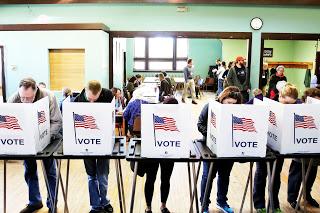 So, nearly everything I suggested was likely yesterday was proven wrong by late last night. So the Political Science 101 model failed the test, right?
So, nearly everything I suggested was likely yesterday was proven wrong by late last night. So the Political Science 101 model failed the test, right?Yes and no. Clearly, it shows how your basic ground-level politicking--the face-time and the hand-shaking, the knocking of doors and the hanging of literature on door handles--can overcome real disparities in paid advertising, when it comes to low-turnout elections where name recognition is paramount. Both Michelle Ballard--the winner over incumbent Cindy Claycomb in District 6--and Mike Hoheisel--the likely winner over incumbent Jared Cerullo in District 3--outperformed those incumbents in the even lower-turnout primary elections in August, so the evidence of their ground-level game was manifest. I simply assumed--as the model does--that when it came to the general election, absent major new voter activization (which the model, and I, mostly associate with media expenditures, since the one-on-one, doorstop activization of irregular voters is, while obviously effective, also very time consuming and very difficult to scale up), those primary accomplishments would be unlikely to indicate success against the advantages of incumbency. That was wrong, and clearly the people around Ballard and Hoheisel (and Mayor Brandon Whipple, who strongly backed both) knew better than what I took Political Science 101 to be teaching. The Hoheisel win, which isn't certain and will be razor-thin regardless, in a very unengaged district and in the face of an incumbent who was essentially still a newcomer to Wichita city politics, was always going to be more likely, and I said so yesterday. But Ballard's triumph, especially once the major motivator of Claycomb's uneven record on a non-discrimination ordinance was resolved in favor of a vote which many in the fairly progressive District 6 wanted, and especially in the face of Claycomb's major media purchases, really was unexpected--as unexpected, according to Political Science 101, as Mayor Whipple's victory in 2019, in fact. So hey, bad for the model, and bad for us to relied too much upon it.
As for the school board elections, there I will not the fault the model, but rather my own application of it. In retrospect, it's pretty clear that, despite my assumption about the levels of name recognition for all four incumbents (based mainly upon advertising paid for by outside Democratic groups which lumped them all together), in fact only one of the incumbents, Julie Hendrick, had sufficient levels of acknowledgment for herself as candidate to withstand the concerted efforts by the GOP to sweep the incumbents out. I knew one of the incumbents, Mia Turner, quite likely would not have been able to build such supportive local associations since her appointment to the seat, but I failed to note Rosales's contentious record in office (and how much the entrance of Holly Terrill, a progressive friend of the winning city council Democrats, into the race would essentially keep that contention information in voters minds, thus lessening and splitting his support), and I simply didn't take seriously enough the efforts of local Republicans to target Ben Blankley specifically. In the end I was quite surprised, but I'm not sure someone who kept a closer eye on the histories and trajectories of each of these candidates would have applied the model as poorly as I did.
In short, yes, the Political Science 101 model can and, in this case, did fail (partly). But I'm also a bad political scientist. Thank goodness I can use my training as a political theorist as an excuse.
